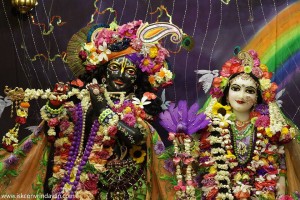Hare Krishna.
6th April, 2014, Gurgaon.
Q: What does the name Radha means ?
Ans :
kṛṣṇa-vāñchā-pūrti-rūpa kare ārādhane
ataeva ‘rādhikā’ nāma purāṇe vākhāne (CC Ādi 3.61)
TRANSLATION
Her worship [ārādhana] consists of fulfilling the desires of Lord Kṛṣṇa. Therefore the Purāṇas call Her Rādhikā.
Srila Prabhupada writes in his purport of this verse
The name “Rādhā” is derived from the root word ārādhana, which means “worship.” The personality who excels all in worshiping Kṛṣṇa may therefore be called Rādhikā, the greatest servitor.
Q: What is paravyoma ?
Ans : The spiritual sky is called paravyoma.
CC Madhya 21.50: “‘Between the spiritual and the material world is a body of water known as the river Virajā. This water is generated from the bodily perspiration of the Supreme Personality of Godhead, who is known as Vedāńga. Thus the river flows.’
CC Madhya 21.51: “‘Beyond the river Virajā is the spiritual nature, which is indestructible, eternal, inexhaustible and unlimited. It is the supreme abode, consisting of three fourths of the Lord’s opulences. It is known as paravyoma, the spiritual sky.
Q: Why is the material world called eka-pāda ?
Ans:
CC Madhya 21.55: “The spiritual world is considered to be three fourths of the energy and opulence of the Supreme Personality of Godhead, whereas this material world is only one fourth of that energy. That is our understanding.
CC Madhya 21.56: “‘Because it consists of three fourths of the Lord’s energy, the spiritual world is called tri-pād-bhūta. Being a manifestation of one fourth of the Lord’s energy, the material world is called eka-pāda.’
Q: When does Krishna descends to this world ?
Ans : Srila Prabhupada writes in his purport of CC Ādi 3.10: From the beginning of Brahmā’s day of 4,320,000,000 years, six Manus appear and disappear before Lord Kṛṣṇa appears. Thus 1,975,320,000 years of the day of Brahmā elapse before the appearance of Lord Kṛṣṇa.
CC Ādi 3.6: Once in a day of Brahmā, He descends to this world to manifest His transcendental pastimes.
CC Ādi 3.7: We know that there are four ages [yugas], namely Satya, Tretā, Dvāpara and Kali. These four together constitute one divya-yuga.
CC Ādi 3.8: Seventy-one divya-yugas constitute one manv-antara. There are fourteen manv-antaras in one day of Brahmā.
CC Ādi 3.9: The present Manu, who is the seventh, is called Vaivasvata [the son of Vivasvān]. Twenty-seven divya-yugas [27 x 4,320,000 solar years] of his age have now passed.
CC Ādi 3.10: At the end of the Dvāpara-yuga of the twenty-eighth divya-yuga, Lord Kṛṣṇa appears on earth with the full paraphernalia of His eternal Vraja-dhāma.
All glories to Śrī Caitanya Caritāmṛta.
All glories to Sri Guru and Gauranga.

